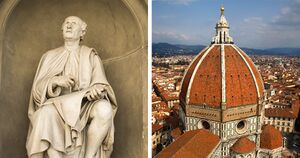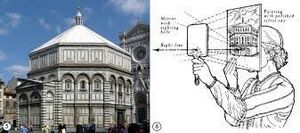Brunelleschi
Filippo Brunelleschi was an architect and engineer, and one of the pioneers of early Renaissance architecture in Italy. He was the first modern engineer and an innovative problem solver, building his major work, the dome of the Cathedral of Santa Maria del Fiore (the Duomo) in Florence, with the aid of machines that he invented specifically for the project.
Early Years
Born in 1377 in Florence, Italy, Brunelleschi's early life is mostly a mystery. It is known that he was the second of three sons and that his father was a distinguished notary in Florence. Brunelleschi initially trained as a goldsmith and sculptor and enrolled in the Arte della Seta, the silk merchants' guild, which also included goldsmiths, metalworkers and bronze workers. Around the turn of the century, he was designated a master goldsmith.
In 1401, Brunelleschi competed against Lorenzo Ghiberti, a young rival, and five other sculptors for the commission to make the bronze reliefs for the door of the Florence baptistery. Brunelleschi's entry, "The Sacrifice of Isaac," was the high point of his short career as a sculptor, but Ghiberti won the commission. Ghiberti went on to complete another set of bronze doors for the baptistery with the help of Renaissance giant Donatello. A hundred years later, Michelangelo said about the doors, "Surely these must be the ‘Gates of Paradise.'"
The Transition to Architecture
Brunelleschi's disappointment at losing the baptistery commission might account for his decision to concentrate his talents on architecture instead of sculpture, but little biographical information is available about his life to explain the transition. (He continued to sculpt, but architecture was the dominant thread in his professional career.) Also unexplained is Brunelleschi's sudden transition from his training in the Gothic or medieval manner to the new architectural classicism.
Perhaps he was simply inspired by his surroundings since it was in this period (1402-1404) that Brunelleschi and his good friend and sculptor Donatello purportedly visited Rome to study the ancient ruins.
Brunelleschi, accompanied by Donatello, made a journey to ancient Rome in order to study the physical presence of Rome's ruins in detail, something no one had done before. Although Donatello remained a sculptor, the trip seems to have had a profound effect on Brunelleschi, and he turned firmly and permanently to architecture in the following decade.
The dome is an absolute masterpiece of art, enchanting the world since the moment of its creation: the symbol of Florence, of Renaissance culture, and of all Western humanism.
The dome was built between 1420 and 1436 to a plan by Filippo Brunelleschi, and is still the largest masonry vault in the world. Such a structure had been planned since the 1300s, but no one was capable of building such a structure, the admirable innovation of Brunelleschi was to create it without reinforcements in wood, since none could have sustained a cupola of this size.
It is an octagonal structure in stone and brick masonry, with external diameter 54.8 metres and interior diameter 45.5 metres, but in fact consisting of two domes: one internal and the other external, each composed of eight "sails", or pendentives. One of these sails has a greater set-back than the others and supports the rest. The two “shells” are united by the structures of 24 meridian and 10 parallel ribs, and the cavity between the twin domes hosts the stairway to the lantern (463 steps). The bricks are laid in herringbone pattern and the external dome is covered in terracotta tiles, marked by eight ribs in white marble. These converge towards the seraglio or “tightening”: the ring at the top, in turn supporting the large lantern.
The Reinvention of Linear Perspective
Early in his architectural career (c. 1410-1415), Brunelleschi "rediscovered" the principles of linear perspective. With the foundation of these principles, one can paint or draw using a single vanishing point, toward which all lines on the same plane appear to converge, and objects appear smaller as they recede into the distance.
Brunelleschi displayed his findings with two painted panels (since lost) of Florentine streets and buildings. By using Brunelleschi's perspective principles, artists of his generation were able to use two-dimensional canvases to create illusions of three-dimensional space, crafting a realism not seen previously.
Linear perspective as an artistic tool soon spread throughout the whole of Italy and then through Western Europe, and has remained a staple in artistic creation since.
Other Works and Death
Brunelleschi is also known for building or rebuilding military fortifications in such Italian cities as Pisa, Rencine, Vicopisano, Castellina and Rimini. He also created a hoist-like mechanism to help stage theatrical religious performances in Florentine churches (to assist angels in flying, for instance) and is credited with securing the first modern patent for a riverboat he invented.
Brunelleschi died in Florence on April 15, 1446, and is entombed in the Duomo. He is remembered as one of the giants of Renaissance architecture. The inscription on his grave within the basilica reads: "Both the magnificent dome of this famous church and many other devices invented by Brunelleschi the architect bear witness to his superb skill. Therefore, in tribute to his exceptional talents, a grateful country that will always remember buries him here in the soil below."
Group members: Andrés Alva, Tomás Rosso, Tomás Prunier, Juan Druetta.

